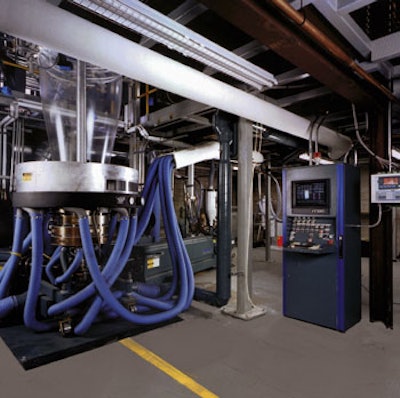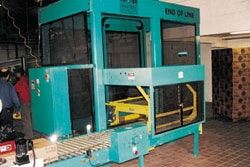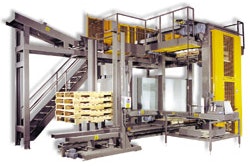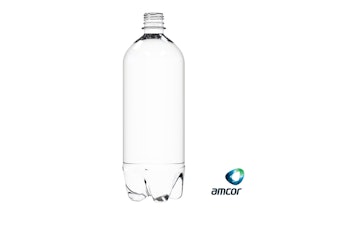
Haremar Plastic Manufacturing Ltd. of Toronto, Canada, literally raised the roof in taking its film extrusion capability to a higher level of quality, consistency and output. The 15’ roof-raising was needed to accommodate a tower that’s part of a state-of-the-art, three-layer extrusion line started up this past summer. Anchored by more than $1 million in equipment from Battenfeld Gloucester Engineering (Gloucester, MA), the line replaced one that was about 10 years old, says Mark Lichtblau, Haremar corporate vice president.
The change from two- to three-layer coextrusion was a quantum leap in capability for Haremar; the company says three-layer films are still relatively untapped by Canadian film makers. It extends the company’s expertise in multilayer films for trash bags, food storage bags, and shrink and overwrap applications. It also allows Haremar to improve products for existing customers like Sons Bakery, which provides wrapped hamburger buns to McDonald’s restaurants in Canada (see sidebar).
But what especially excites Lichtblau is the line control. The entire system, from blending and extrusion to winding, was integrated into a single point of control with Battenfeld Gloucester’s Extrol® 6032 microprocessor control unit (see sidebar, p. 26). It features Extrol Anywhere™ technology to monitor the ’round-the-clock operation while it also permits remote servicing.
The three-layer line can handle a diverse range of resins in a wide range of thicknesses. Resins include high-density polyethylene, linear low-density PE, LDPE and ethylene vinyl acetates, Lichtblau states, adding that they also use UV inhibitors and anti-statics. Haremar has extruded films from 0.4 mil to 5 mil, Packaging World is told.
Lichtblau states that the only similarity between the new and the old line is the common geography of the plant floor. “The layflat film is consistently flatter. We get improved yield, more consistency and, in the long run, lower costs,” he says. Film consistency, a hallmark of the entire system, starts with extrusion.
Starts with extrusion
The bank of three Battenfeld Contracool® extruders—two with 2’’ screws and one 3’’—use five different zones to evacuate air. Having tighter control of temperature at this point results in a more consistent thickness of the film bubble. Typically, the larger extruder produces the middle layer of a three-layer structure.
The material from the extruders is directed through a common block and then to the circular die from where, with a pressurized air ring, it rises skyward.
At the top of a 35’ tower, the bubble is converted into layflat orientation through an
A-frame assembly and then by primary and secondary nip rollers. Lichtblau points out that the first nip is an 84’’-capacity-wide Transversanip oscillating system from Battenfeld. It rotates 360° in one direction, then 360° back, to smooth out bubble gauge variations. It’s a great contributor to consistency. He says this eliminates the need for an oscillating die at the extruder, thus reducing a chance for seal leakage during extrusion. Rotation timing is programmable; Haremar uses a 10-minute cycle set time.
In between the two nips, film destined for printing is full-layflat corona treated. The electrical charge roughens the film surface to permit a better ink bond.
The film then goes through a web guide that, using proximity sensors, centers it ahead of edge trimming. The trimmed material is reclaimed and reused. The material can also be slit at this point. Haremar’s slitting options enable it to supply folded, U-shape film or film slit into as many as six rolls. The film is wound into rolls on a two-turret winder that can handle roll diameters of up to 30’’ and widths to 70’’. The winder is a ’98 vintage Battenfeld unit used on the previous line. Lichtblau says $100 worth of new gears upgraded its speed by 100’/min to match the new line’s capacity.
The new line increases speeds up to 450’/min, a 38% increase over the previous line’s 325’/min.
Faster is better, but even more important is consistency, which Lichtblau emphasizes is really the bottom line. “Improved consistency is one thing a customer will never complain about,” Lichtblau says, adding that the new line’s film variance is now half of what it was before as measured by standard deviation. And he attributes that to the many “small” things along the entire line.
When asked about the return-on-investment for the overall C$2- million cost of the line, Lichtblau responds, “It’s immediate, due to the positive impact it has on the employees, our company’s reputation and also in raising the standard for the industry.”
See sidebar to this article: Film wraps McDonald’s Canadian buns
See sidebar to this article: Central and remote control






















